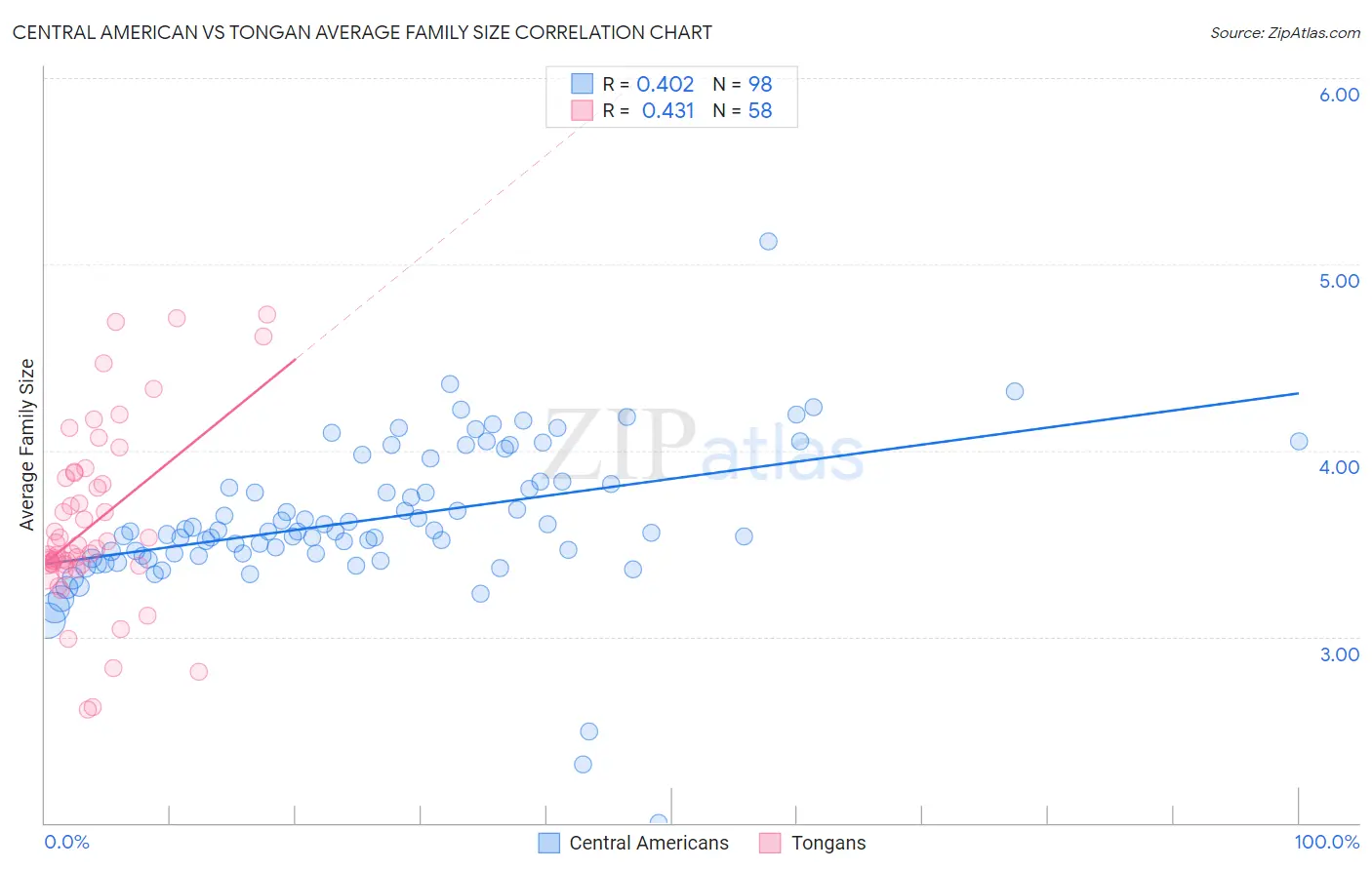Central American vs Tongan Average Family Size
COMPARE
Central American
Tongan
Average Family Size
Average Family Size Comparison
Central Americans
Tongans
3.41
AVERAGE FAMILY SIZE
100.0/ 100
METRIC RATING
31st/ 347
METRIC RANK
3.49
AVERAGE FAMILY SIZE
100.0/ 100
METRIC RATING
15th/ 347
METRIC RANK
Central American vs Tongan Average Family Size Correlation Chart
The statistical analysis conducted on geographies consisting of 504,084,527 people shows a moderate positive correlation between the proportion of Central Americans and average family size in the United States with a correlation coefficient (R) of 0.402 and weighted average of 3.41. Similarly, the statistical analysis conducted on geographies consisting of 102,872,564 people shows a moderate positive correlation between the proportion of Tongans and average family size in the United States with a correlation coefficient (R) of 0.431 and weighted average of 3.49, a difference of 2.3%.

Average Family Size Correlation Summary
| Measurement | Central American | Tongan |
| Minimum | 2.00 | 2.61 |
| Maximum | 5.12 | 4.73 |
| Range | 3.12 | 2.12 |
| Mean | 3.63 | 3.60 |
| Median | 3.56 | 3.46 |
| Interquartile 25% (IQ1) | 3.43 | 3.39 |
| Interquartile 75% (IQ3) | 3.83 | 3.85 |
| Interquartile Range (IQR) | 0.40 | 0.47 |
| Standard Deviation (Sample) | 0.41 | 0.48 |
| Standard Deviation (Population) | 0.40 | 0.47 |
Demographics Similar to Central Americans and Tongans by Average Family Size
In terms of average family size, the demographic groups most similar to Central Americans are Immigrants from Guatemala (3.41, a difference of 0.10%), Hawaiian (3.41, a difference of 0.12%), Samoan (3.42, a difference of 0.20%), Nepalese (3.42, a difference of 0.23%), and Immigrants from Latin America (3.42, a difference of 0.32%). Similarly, the demographic groups most similar to Tongans are Immigrants from Central America (3.49, a difference of 0.050%), Ute (3.49, a difference of 0.060%), Immigrants from El Salvador (3.49, a difference of 0.15%), Salvadoran (3.48, a difference of 0.40%), and Mexican (3.48, a difference of 0.46%).
| Demographics | Rating | Rank | Average Family Size |
| Sioux | 100.0 /100 | #13 | Exceptional 3.52 |
| Immigrants | Central America | 100.0 /100 | #14 | Exceptional 3.49 |
| Tongans | 100.0 /100 | #15 | Exceptional 3.49 |
| Ute | 100.0 /100 | #16 | Exceptional 3.49 |
| Immigrants | El Salvador | 100.0 /100 | #17 | Exceptional 3.49 |
| Salvadorans | 100.0 /100 | #18 | Exceptional 3.48 |
| Mexicans | 100.0 /100 | #19 | Exceptional 3.48 |
| Cheyenne | 100.0 /100 | #20 | Exceptional 3.47 |
| Yuman | 100.0 /100 | #21 | Exceptional 3.47 |
| Apache | 100.0 /100 | #22 | Exceptional 3.46 |
| Immigrants | Fiji | 100.0 /100 | #23 | Exceptional 3.45 |
| Natives/Alaskans | 100.0 /100 | #24 | Exceptional 3.45 |
| Yakama | 100.0 /100 | #25 | Exceptional 3.45 |
| Native Hawaiians | 100.0 /100 | #26 | Exceptional 3.43 |
| Mexican American Indians | 100.0 /100 | #27 | Exceptional 3.43 |
| Immigrants | Latin America | 100.0 /100 | #28 | Exceptional 3.42 |
| Nepalese | 100.0 /100 | #29 | Exceptional 3.42 |
| Samoans | 100.0 /100 | #30 | Exceptional 3.42 |
| Central Americans | 100.0 /100 | #31 | Exceptional 3.41 |
| Immigrants | Guatemala | 100.0 /100 | #32 | Exceptional 3.41 |
| Hawaiians | 100.0 /100 | #33 | Exceptional 3.41 |